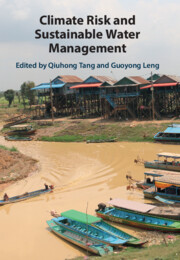Book contents
- Climate Risk and Sustainable Water Management
- Climate Risk and Sustainable Water Management
- Copyright page
- Contents
- Contributors
- Preface
- Acknowledgements
- Part I Water-Related Risks under Climate Change
- Part II Climate Risk to Human and Natural Systems
- Part III Sustainable Water Management under Future Uncertainty
- Index
- References
Part I - Water-Related Risks under Climate Change
Published online by Cambridge University Press: 17 March 2022
- Climate Risk and Sustainable Water Management
- Climate Risk and Sustainable Water Management
- Copyright page
- Contents
- Contributors
- Preface
- Acknowledgements
- Part I Water-Related Risks under Climate Change
- Part II Climate Risk to Human and Natural Systems
- Part III Sustainable Water Management under Future Uncertainty
- Index
- References
Summary

- Type
- Chapter
- Information
- Climate Risk and Sustainable Water Management , pp. 1 - 136Publisher: Cambridge University PressPrint publication year: 2022

